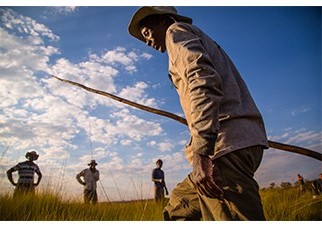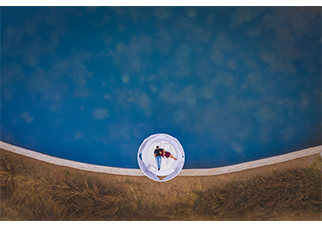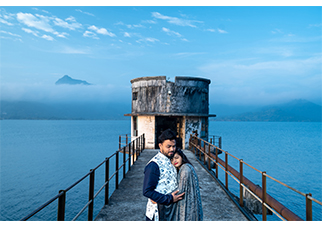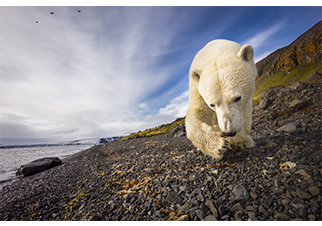Excerpts:
What is the level of preparations that an adventure photographer undergoes ahead of any expedition?
These trips are months, if not years of making. Often times before a large expedition, like the one with the Rolls-Royce Cullinan I spent a few months in preparation, learning about the place I was going and doing research, then a couple of weeks of packing, making sure I had all the equipment I needed from a photography perspective. These things are logistical puzzles, some people would call them nightmares, some people would call them an absolute dream. I tend to think of them more as nightmares and I am always blown away by the capacity of the teams that come together and orchestrate these massive endeavours.
If you look back at all the time that I am putting into my next adventure, which I’m embarking on in spring, it is literally ten years of work. The acute preparation is around three months while the training period is about a year.
Despite vigorous preparation factors like isolation, fatigue among others take one to the edge of their mental toughness. Do you think any level of prep can do that?
I mean you can’t prepare for the rapid shifts that may or may not happen in an assignment or an expedition, because all you can do is adapt to the moment as it unfolds. That’s the nature of expeditions or exploration. The only thing that prepares for that kind of decision- making is doing that decision-making. You will not know what those decisions are going to be or what is going to predicate them.
I found that pushing through hard things have been radically trained by small things that I do at home which include my day-to-day workouts that I really push myself through. That could be incremental like pushing yourself to do more reps? Those little mechanisms we teach our mind to do in our day-to-day lives have profound impact on your morality out in the field. Also, setting goals and achieving them, accomplishing small digestible goals. When you finally reach that end where you push through your absolute limit, it will be by breaking down that final goal into digestible pieces.
What are the practical difficulties that a photographer faces while shooting in such extreme conditions?
The practical difficulties I encounter are usually environmental. Either extreme cold or extreme heat, wind. For example, when I was shooting with Rolls-Royce, we were taking the Cullinan through the Empty Quarter and we were hit by a massive sandstorm in the middle of the dessert that thrashed one of my best cameras. That’s one of those things we have to adapt to and those are sort of the environmental challenges that I encounter. On the other hand, in extreme cold conditions you are trying to keep things powered up, like your camera battery. But really, the things that are hardest are the mental hurdles, being away from home, being away from loved ones, being in life-threatening situations and accessing the risk and breaking down ambition versus reality. Those things are much more taxing, they don’t have the same acute challenge as the environmental hurdles that I often face. They are bigger life decisions and often require more attention.

Apart from a camera, any camera, it doesn’t have to be the best thing in the world. It can be a phone camera. But otherwise, a kindle or reading tablet, for me, is pivotal because it allows me an escape and allows me to stay educated and keep my mind engaged. That’s one thing that I find really powerful, keeping your mind active when you are on these long expeditions or explorations.
Having a way to diversify your thought process, be it through music or reading, so you are not constantly fatiguing your brain thinking about the objective. Another thing that is very helpful for me is my meditation practice. Again, it gives my mind a hard reset. It is something I can do on a daily basis that requires nothing but my own willingness to engage with it. I think it functionally helpful in engaging the creative process as well as to continue to foster that curiosity throughout the expedition.
What is the best and the worst memory from your expeditions/shoots?
I think usually the best is usually is the worst. Because usually a really difficult situation that comes up or something that is really impactful ends up pushing you towards growth. I can point to one that is very well known, and that is the avalanche on Gasherbrum II years ago. That was one of the most unpleasant, horrific, scary experiences of my life. But it was also a moment that pushed my career into a new trajectory. It opened a lot of doors, it made me examine myself and my own experiences with climbing and my identity and pushed me down a path towards bettering myself.
Here’s this moment that was horrifically frightening, a near-death experience, it put me through a cycle of Post-Traumatic Stress Disorder and I also got divorced. I started drinking too much and all of that ends up being this gateway into this new life, which has allowed me to grow and push beyond certain areas in my life I never thought that were possible. It has allowed me to excel and evolve as a human.

Given the current challenging scenario globally, how do you think this will change this genre, especially since travelling might be challenge for some time to come?
I don’t know that it will change the genre. I think what it is going to do is slow it for a certain period of time. I think we are going to see a dramatic reduction in the rampant travelling that we were enjoying for so long and honestly, it is a healthy pause for the planet. I think it is a healthy pause for all of us, but I don’t think it will change the genre. I think we need to be more intentional with the trips we take, with the stories we want to tell. I hope that if it changes, it would move us to adventures with purpose versus adventure for adventure’s sake.
While covering war-affected or unfortunate areas, how do you as a photographer isolate your emotions to capture the moment as is?
Honestly, there is a lot of emotional feedback, especially when you are in an area that is affected by conflict or you are in a more impoverished area. First and foremost, I try to interpret the experience by not shutting myself down emotionally and feeling what comes up for me. Quite often, those feelings are amplified or sourced from my own ignorance, my own naivety, my own privilege. So again, the emotional upwelling, when it happens, is kind of a source of information, so I never try it shut it down.
Infact, I try to use that emotion to move me towards a better picture. If I can feel and engage with the emotional response that I am having, that can direct me towards more meaningful photography, and more meaningful art. The art should be informed by the emotion, and not outside of the emotion. If I am affected, ultimately the goal is to photograph what it feels like, not what it looks like. That’s the key for great photography. I don’t mean to show people what it looks like, I need to show them what it feels like. If I can accomplish that, then I think I can accomplish something more transcendent. The only way I can do that is to be in touch with what it actually feels like: good, bad, hard, heart- wrenching at times. But those things are informative.

Any tips that you would like to give the upcoming and young talent?
Actually, you are absolutely right, there are more story-tellers on a much more global scale than we ever have. I used to think this was a very euro-centric endeavour, and I think that that is tied to the history of how the world was when it comes to exploring. I am being kind in the way I am describing that right now. I am excited to see the very faces in the diverse group of story tellers that are coming up all over the world.
My encouragement is the same with any young storyteller: Find what you are actually passionate in talking about, not what you think looks good or getting likes on social media. Find a story or stories that move you, genuinely move you, that really does ignite your limbic resonance, or your emotional response. Pursue those. Find what drives you and find a cause that you are passionate about and pursue those. If that is adventure, then great. But make sure your adventures have some purpose behind them. Try to find that purpose and with that driving force, pursue them all the way to the grave and keep pursuing them beyond when you think they are already done. Pursue those long, big stories. But pursue what you are actually passionate about, not what you think is going to get you recognition or likes, not what you think is the thing to pursue in that moment. That’s not helpful, what’s helpful is your passion.
What was the objective of collaborating with the Cullinan and did a camouflaged SUV help during this adventure?
I don’t think the wrap of the Cullinan helped at all, in fact if anything it made us more visible. The wraps are designed to make the car more difficult to photograph. The car itself, absolutely facilitated an amazing adventure, a global exploration that I could never have anticipated. The fusion of National Geographic and Rolls-Royce in this context made a lot of sense. What we were doing was trying to test how far the car could go. We were essentially field-testing and trying to break it. We didn’t break it, so it says something about it. We were also using it to facilitate truly a global exploration of the Scottish Highlands, into the Empty Quarter, in Middle East and all across the American West. It was really about testing and seeing how far I could push the automobile and the drivers, to see how much the car can take. It was just a luxurious and comfortable ride I have ever had on any other assignment.

My weapons of choice are always Nikon. I love their Z system, they are the mirrorless cameras, their big D-8 cameras are amazing as well. Those are my workhorse cameras, the Z6 and the Z7. The Z6 is really great for videos and the Z7 is unmatched in terms of mirrorless performance in terms of still photography. They are light, they’re robust, they are unbreakable. That is my arsenal. But again, I always have to promote, you don’t have to have the best and the greatest. You can shoot film, you shoot on your camera phone or whatever you want. Just shoot. If you don’t shoot, you miss 100% of the shots you don’t take, to quote Wayne Gretzky.

